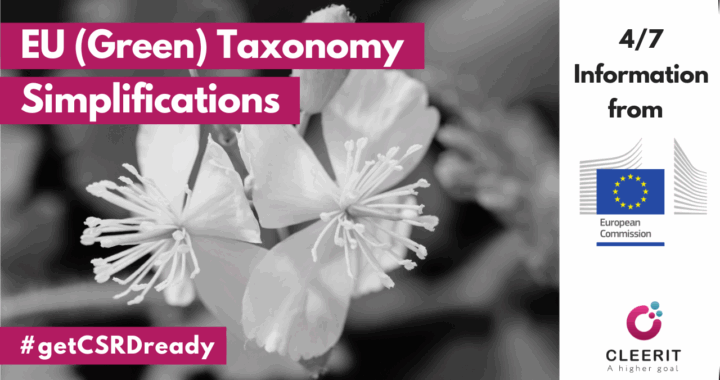On July 4, the European Commission adopted a set of measures to simplify the application of EU (Green) Taxonomy.
The changes include simplified reporting templates for non-financial undertakings that will result in a reduction of reported data points (in the case of one Taxonomy-aligned activity) from 78 to 28, which is a 64% reduction.
The simplification measures include:
Simplification of summary KPI template
One static template for summary information, which will merge in one template instead of three the summary KPIs presented according to current rules in ‘per activity information’ reporting, while the ‘per activity’ templates provide for more detailed sectoral breakdowns.
Are also removed: summary information on non-eligible activities, information per objective (eligible activities, eligible but not aligned activities, transitional and enabling activities), separate reporting on datapoints for DNSH and minimum safeguards for Taxonomy-aligned activities.
A new column is introduced to provide transparency on the non-assessed proportion of the denominator of the respective KPIs that non-financial undertakings consider as not material.
Simplification of ‘per activity’ information
For Taxonomy-aligned activities, the changes introduce the reporting of one activity per row, suppressing:
- reporting on separate rows on the portions of activity aligning with different environmental objectives;
- reporting separately on DNSH and minimum safeguards, any contribution to multiple environmental objectives;
- reporting of explicit information for non-aligned activities (these can be still derived implicitly from the datapoints that remain).
Suppression of Annex XII
The entire Annex XII with the separate templates on the performance and exposures to the fossil gas and nuclear activities will be suppressed.
The non-financial undertakings will report on those activities, where material in the ‘per activity’ template.
Financial undertakings will report on those activities, where relevant, in an aggregate form in their standard template which will reduce the number of reported cells from 166 to 4 per KPI.
Introduction of a de minimis materiality threshold of 10 %
A de minimis threshold of 10 % will allow reporting companies to focus their efforts on assessing the taxonomy-eligibility and alignment of activities that represent a significant share of their revenues, CapEx or CapEx, and how they contribute to their transition efforts.
For non-financial companies, activities are considered non-material if they account for less than 10% of a company’s total revenue, capital expenditure (CapEx) or operational expenditure (OpEx).
In addition, non-financial companies are exempt from assessing Taxonomy alignment for their entire operational expenditure when it is considered non-material for their business model.
—
The Delegated Act will now be transmitted to the European Parliament and the Council for their scrutiny. The changes will apply once the scrutiny period of 4 months, which can be prolonged by another 2-month period, is over.
The simplification will apply as of 1 January 2026 and will cover the 2025 financial year – with the option to start with the 2026 financial year if reporting company finds this more convenient.
Links to the Delegated Act and the press release:
https://ec.europa.eu/commission/presscorner/api/files/document/print/en/ip_25_1724/IP_25_1724_EN.pdf
#getCSRDready, #CSRD, #ESG, #Strategy, #Governance, #SustainabilityReporting, #Digitalisation, #Cleerit
